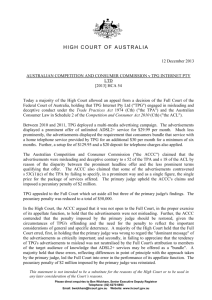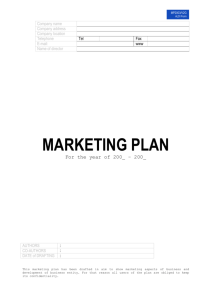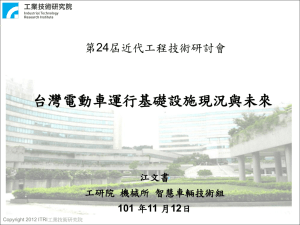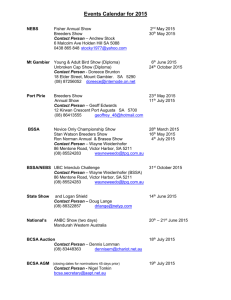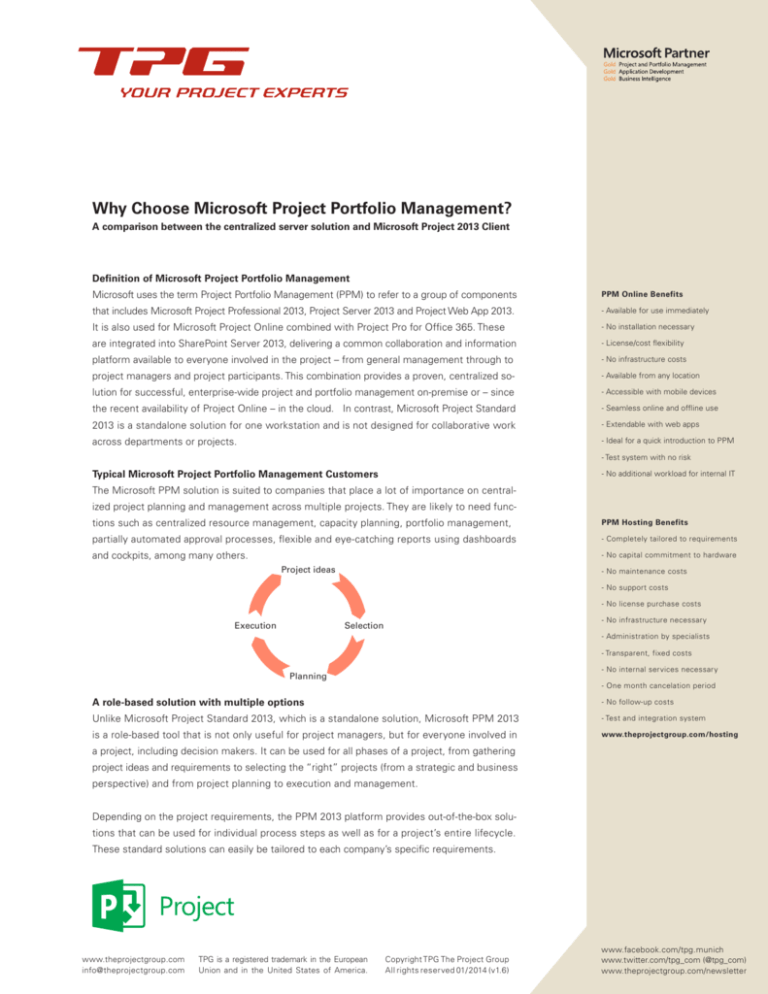
Why Choose Microsoft Project Portfolio Management?
A comparison between the centralized server solution and Microsoft Project 2013 Client
Definition of Microsoft Project Portfolio Management
Microsoft uses the term Project Portfolio Management (PPM) to refer to a group of components
PPM Online Benefits
that includes Microsoft Project Professional 2013, Project Server 2013 and Project Web App 2013.
- Available for use immediately
It is also used for Microsoft Project Online combined with Project Pro for Office 365. These
- No installation necessary
are integrated into SharePoint Server 2013, delivering a common collaboration and information
- License/cost flexibility
platform available to everyone involved in the project – from general management through to
- No infrastructure costs
project managers and project participants. This combination provides a proven, centralized so-
- Available from any location
lution for successful, enterprise-wide project and portfolio management on-premise or – since
- Accessible with mobile devices
the recent availability of Project Online – in the cloud. In contrast, Microsoft Project Standard
- Seamless online and offline use
2013 is a standalone solution for one workstation and is not designed for collaborative work
- Extendable with web apps
across departments or projects.
- Ideal for a quick introduction to PPM
- Test system with no risk
Typical Microsoft Project Portfolio Management Customers
- No additional workload for internal IT
The Microsoft PPM solution is suited to companies that place a lot of importance on centralized project planning and management across multiple projects. They are likely to need functions such as centralized resource management, capacity planning, portfolio management,
PPM Hosting Benefits
partially automated approval processes, flexible and eye-catching reports using dashboards
- Completely tailored to requirements
and cockpits, among many others.
- No capital commitment to hardware
Project ideas
- No maintenance costs
- No support costs
- No license purchase costs
Execution
- No infrastructure necessary
Selection
- Administration by specialists
- Transparent, fixed costs
- No internal services necessary
Planning
- One month cancelation period
A role-based solution with multiple options
- No follow-up costs
Unlike Microsoft Project Standard 2013, which is a standalone solution, Microsoft PPM 2013
- Test and integration system
is a role-based tool that is not only useful for project managers, but for everyone involved in
www.theprojectgroup.com/hosting
a project, including decision makers. It can be used for all phases of a project, from gathering
project ideas and requirements to selecting the “right” projects (from a strategic and business
perspective) and from project planning to execution and management.
Depending on the project requirements, the PPM 2013 platform provides out-of-the-box solutions that can be used for individual process steps as well as for a project’s entire lifecycle.
These standard solutions can easily be tailored to each company’s specific requirements.
www.theprojectgroup.com
info@theprojectgroup.com
TPG is a registered trademark in the European
Union and in the United States of America.
Copyright TPG The Project Group
All rights reserved 01/ 2014 (v1.6)
www.facebook.com/tpg.munich
www.twitter.com/tpg_com (@tpg_com)
www.theprojectgroup.com/newsletter
Gathering project ideas
Using workflows, ideas for a project can be gathered from members of the team. The process
starts with the collection of rudimentary data and these suggestions are then enriched
with structured data (such as a business plan), making it easier to prioritize one project over
another. With SharePoint Designer 2013 and Visio 2013, users can now also create graphical
workflows.
With SharePoint Designer 2013 and Visio
2013, users can now also create graphical
workflows
Integrated Portfolio Management
The new portfolio management functions in Microsoft Project Server 2013 and in Project Online
help companies compile their project portfolio and select the projects to be executed. Selection criteria can be purely financial (budget, resource availability etc.) or include “soft” factors
as well (such as customer satisfaction) that companies can define as they wish.
Portfolio management functions help
companies compile their project portfolio
and select the projects to be executed.
www.theprojectgroup.com
info@theprojectgroup.com
TPG is a registered trademark in the European
Union and in the United States of America.
Copyright TPG The Project Group
All rights reserved 01/ 2014 (v1.6)
www.facebook.com/tpg.munich
www.twitter.com/tpg_com (@tpg_com)
www.theprojectgroup.com/newsletter
Microsoft Project Standard / Professional /Project Pro für Office 365
Project managers with experience in Microsoft Project 2013 Standard will quickly get to grips
with the interface of the Professional version and the cloud-based Project Pro for Office 365
version. The main difference is communication with the server, which is only possible with the
Professional and Project Pro versions. A new feature in these versions is that predefined and
user-defined reports can be created and viewed directly in Microsoft Project.
Users with experience in Microsoft
Project 2013 Standard will quickly get
to grips with the interface of the Professional and the cloud-based Project
Pro for Office 365 versions.
Working on projects in the browser with the Project Web App
The new PPM solution also allows users to create and work on projects in the browser-based
Web App. This is made easier by the fact that the complete computation logic from the Client
version is now available in Project Web App.
Project participants can use Project
Web App to access an overview of all
the work packages assigned to them.
While the Microsoft Project 2013 Professional and Project Pro for Office 365 client is exclusively
used by people involved in detailed project planning and management processes, all other
participants and decision-makers only work with the browser-based Project Web App. The
advantage of solely using the Web App is that license costs are significantly lower. Project
participants can use Project Web App to access an overview of all the projects they have been
assigned to, view their work packages, and fill in their timesheets.
www.theprojectgroup.com
info@theprojectgroup.com
TPG is a registered trademark in the European
Union and in the United States of America.
Copyright TPG The Project Group
All rights reserved 01/ 2014 (v1.6)
www.facebook.com/tpg.munich
www.twitter.com/tpg_com (@tpg_com)
www.theprojectgroup.com/newsletter
Project participants can use the Web App
to fill in their timesheets and administration times.
Managers can access the Project Web App anytime to see current reports as well as analyses
of the project portfolio. The centralized resource pool gives them a clear overview of the workload of resources that have been assigned to several different projects.
The resource availability function can be
used to optimize workloads. It shows all
the available resources and which projects
they are working on.
Central and standardized document storage using SharePoint
To facilitate end-to-end project communication, project sites are available on the Windows SharePoint Server, which is the technology underpinning the seamlessly integrated Project Server
2013 and Project Online 2013. It provides a central and standardized way to store documents
and update additional information. Topics like risks and problems can be managed using lists
that can be assigned to individual projects and/or tasks.
Extensions with Project and SharePoint Apps
A new feature in the 2013 version is that apps can be used to extend the PPM solution’s functional scope. The chart below shows three of these: the TPG MTA Chart app for milestone
trend analysis; the TPG Risk Chart app that shows risks in a matrix listed by impact and probability; and the TPG WBS Chart app that lets users create an easy-to-read work breakdown structure.
www.theprojectgroup.com
info@theprojectgroup.com
TPG is a registered trademark in the European
Union and in the United States of America.
Copyright TPG The Project Group
All rights reserved 01/ 2014 (v1.6)
www.facebook.com/tpg.munich
www.twitter.com/tpg_com (@tpg_com)
www.theprojectgroup.com/newsletter
TPG MTA Chart, TPG Risk Chart and
TPG WBS Chart apps extend the
functionality of Microsoft Project 2013
and are available in the Microsoft
SharePoint Online Store.
Optimized for use on mobile devices
Project Online is a new cloud-based solution and is part of Microsoft Office 365, which gives
users complete flexibility to work on their projects while they are out of the office. A useful
new feature that underlines this commitment to mobility is the ability to hide and show the
PWA navigation bar. This makes it easier to view more content on small screens such as
tablets.
Project data on the server can also be stored offline if required, making it easier to carry them
around and work on them without a server connection. Once the user connects to the server
again, the updated information on the local device is synchronized to the server.
Multiple advantages from centralized project data storage
The ability to centralize structured information about all projects is one of the biggest advantages of Microsoft PPM 2013 compared to standalone solutions. Authorized users have a
range of other options available to them, including reporting and analyses that are easy to
access via SQL Reporting Services. There are also extensive Excel Services and Performance
Point Services, both of which are already integrated into SharePoint Server 2013 (Enterprise
Version).
www.theprojectgroup.com
info@theprojectgroup.com
TPG is a registered trademark in the European
Union and in the United States of America.
Copyright TPG The Project Group
All rights reserved 01/ 2014 (v1.6)
www.facebook.com/tpg.munich
www.twitter.com/tpg_com (@tpg_com)
www.theprojectgroup.com/newsletter
The Advantages of Microsoft Project Portfolio Management – Point by Point
Centralized data management
Central data pool: all data are stored on a central Microsoft SQL server in a single database,
which provides extensive analysis capabilities.
-- Multi-project and portfolio management: important performance data and projects can be
quickly monitored and analyzed in the Project Center.
-- What-if analyses for portfolios are available to assist with project selection.
The Project Center provides an excellent
overview of key performance data,
which can be made even clearer with
graphics such as configurable traffic-light
indicators
Project life cycle with workflows
-- Project idea gathering / selection process: A small set of basic data (e.g. topic and
project description) is usually enough to start a collection of new ideas. As the selection
process continues, more information should be added (e.g. budget, resource and skill
requirements etc.). Further selection steps can be workflow-driven and made dependent
on approvals if required.
-- Project selection / approval process: Based on “hard” criteria (such as budget or resources)
and on predefined “soft” criteria (customer satisfaction, market awareness etc.), the system
suggests the optimal project portfolio to decision makers. By selecting or changing various
parameters, customers can review a number of different scenarios.
-- Project planning: Microsoft Project 2013 provides project planners with all the standard
options for schedule, resource and cost planning. With the consistent use of the central
resource pool on the Project Server, they always have visibility into resource availability
and workloads across all projects.
-- Project execution: Planned activities are automatically communicated to project participants, making it easier to plan and manage project execution. Team members provide
feedback about progress directly within the project plan, so managers can view the status
of a project at any time. This makes reporting significantly easier.
www.theprojectgroup.com
info@theprojectgroup.com
TPG is a registered trademark in the European
Union and in the United States of America.
Copyright TPG The Project Group
All rights reserved 01/ 2014 (v1.6)
www.facebook.com/tpg.munich
www.twitter.com/tpg_com (@tpg_com)
www.theprojectgroup.com/newsletter
A particular highlight is that updates to project plans can be communicated quickly. In addition,
the Project Webspace provides an efficient platform that makes up-to-date project-related
content and information available anytime and from any location.
Collaboration
-- Flexible access to information: viewing and using specific project data in the Project Web
App (across projects, departments, and locations, project teams, managers and suppliers)
is dependent on permissions.
-- Feedback: team members can use the Web App to enter their actuals and work completed as well as their remaining work.
-- Depiction of different organization types: centralized directives concerning project and
resource structures as well as mandatory information.
Resource management
-- Enterprise-wide resource pool: this provides an overview of all available resources, their current
workload levels and the projects they have been assigned to in order to avoid overload and optimize capacity utilization.
-- Skill management: a function for managing the capabilities of each individual resource.
-- Generic resources: these facilitate the initial planning of resources based on skills, groups or
departments and without naming team members.
-- Reservation of resources: this is a preparatory step before the firm commitment of resources
and enables these resources to be shown separately in the project analysis.
-- Budget resources: rough planning on the project level that can be compared later on with the
detailed plan.
-- Team resources: Process of assigning a task to a team. If a substitution arrangement is in place,
any team member can be booked to work on the task.
Reporting
-- Analyses across projects: project lists can be grouped together and filtered in the Project Web
App, and have data fields added to them that are useful for analyses.
-- Portfolio reports: browser-based analysis of project and portfolio data in the form of graphics
and tables using Online Analytical Processing (OLAP) or OData in Project Online.
-- Complete Office integration: this makes it easy to generate status reports in Microsoft Excel or
Visio quickly and automatically.
-- Export to external systems: reports can be exported to Excel for further editing. Note: Web
apps can be used to integrate reports. Examples include TPG’s products TPG MTA Chart for
milestone trend analysis, an easy-to-read combination of the history and forecast of selected
milestones with a chart showing time-related deviations. Other products include the TPG Risk
Chart app that shows risks in a matrix listed by impact and probability, helping project managers to set priorities and develop a response to counter risks; and the TPG WBS Chart app that
shows the work breakdown structure and progress overview at the touch of a button.
www.theprojectgroup.com
info@theprojectgroup.com
TPG is a registered trademark in the European
Union and in the United States of America.
Copyright TPG The Project Group
All rights reserved 01/ 2014 (v1.6)
www.facebook.com/tpg.munich
www.twitter.com/tpg_com (@tpg_com)
www.theprojectgroup.com/newsletter
The Burndown Chart is a completely new
report available in Project Client
Documentation (only available with use of project websites in SharePoint Server)
-- Centralized document management: this provides a central file storage area in SharePoint
and enables documents to be attached to individual tasks.
-- Protected project area: every project has its own project area in SharePoint with specific
access permissions.
-- Management of risks and unresolved issues: additional information on projects and individual tasks in the project plan.
-- Cross-referenced information: users can link project documents, lists and tasks to facilitate the retrieval of all interrelated information.
-- Easy creation and management of workspaces and sub-workspaces (e.g. for project meetings).
-- Fast bidirectional access to and from the project in Project Web App or in the client and
from the website to the project.
Data Security
-- Built on a database: all data are stored in SQL Server.
-- Role and permissions concept: differentiated access for project managers, participants,
resource managers, team leaders, executive management etc. Companies can choose
between a SharePoint Permission Mode and a Project Server Permission Mode when
setting up their role and permission concept.
-- Data protection: automatic backups increase security.
-- Data recovery: restores the entire database or individual projects and documents.
-- Fast and secure data access with SSL encryption.
Integration
-- Synchronization with Active Directory: this enables customers to synchronize login
data for resources (see also the TPG ResourceLink product that automatically imports
resources data).
-- Integration with external systems: Microsoft PPM is an extendable platform with a documented database model. It offers full integration with Microsoft Office (TPG products
utilize this, e.g. TPG PSLink for integration with SAP).
-- Integration with Outlook: project-related timesheet reporting and feedback can be carried
out using Outlook.
www.theprojectgroup.com
info@theprojectgroup.com
TPG is a registered trademark in the European
Union and in the United States of America.
Copyright TPG The Project Group
All rights reserved 01/ 2014 (v1.6)
www.facebook.com/tpg.munich
www.twitter.com/tpg_com (@tpg_com)
www.theprojectgroup.com/newsletter
Your Microsoft PPM System – targeted to your needs and available fast
Enterprise-wide portfolio and project management increases transparency and efficiency in
your company. It’s no surprise that more and more firms are choosing to use it – while optimizing or reorganizing their existing processes. TPG The Project Group helps you make the
right decision from the outset – with consulting, implementation and operation.
TPG QuickStart – to get up and running quickly and cost-effectively
TPG QuickStart is a preconfigured PPM solution based on Microsoft Project Server 2010/2013.
It meets the majority of requirements for a project and portfolio system and can be set up
rapidly – at a fixed price. The implementation comprises the following seven phases.
Phase 1
Kickoff and
Scoping
Phase 2
Analysis requirements
Phase 3
Installation
Phase 4
Configuration
Phase 5
Training
Phase 6
Coaching
Phase 7
Handover
This approach gives you a fast, cost-effective and successful introduction to Microsoft PPM.
It combines generic project management methods with best practices from various industries, delivering the benefits of a PPM solution in just a few days. The platform is ready to
use immediately and can be extended as your company grows, eventually becoming an
enterprise-wide solution.
How does TPG QuickStart work?
TPG QuickStart gives you immediate access to proven project management methods and
functions. It includes a preconfigured security concept, project templates, a pre-populated
enterprise resource pool, views and reports, and risk and issue lists for one project lifecycle.
Preconfigured standard functions
Alongside basic functions like project creation, resource planning, time management and
analyses, TPG QuickStart also includes calculated fields, selection lists, tables, filters and
calendars. This ensures complete support for portfolio management functions.
Find out more at www.theprojectgroup.com/quickstart
TPG 5-Phase Method – the enterprise-wide solution tailored to your needs
The TPG 5 Phase Method differs from TPG QuickStart in that it provides a more customized
approach. It starts by specifying the exact requirements of the customer.
Phase 1
Workshop
Phase 2
Implementation
Phase 3
Pilot
Phase 4
Rollout
Phase 5
Operation
Based on a pilot system tested under real-life conditions, the solution takes shape and is
tailored to your exact needs. If required, it can also be integrated with external systems such
as SAP and databases. Find out more at www.theprojectgroup.com/5phasemethod
www.theprojectgroup.com
info@theprojectgroup.com
TPG is a registered trademark in the European
Union and in the United States of America.
Copyright TPG The Project Group
All rights reserved 01/ 2014 (v1.6)
www.facebook.com/tpg.munich
www.twitter.com/tpg_com (@tpg_com)
www.theprojectgroup.com/newsletter
Technical Requirements for Microsoft PPM 2013
Recommended hardware for Microsoft Project Server 2013
-- Physical hardware is recommended, but virtual can be used
-- Processor: 64-bit, quad-core, 2.5 GHz per processor core
-- RAM: 8GB for Project Server, 16GB for SQL Server
-- Disk space required: >200GB
-- Available on a single server, multiple servers or a server farm
Software for Microsoft Project Server 2013
-- Operating system: Windows Server 2008 R2 (64-bit) with at least Service Pack 1
-- Database: SQL-Server 2012 (64-bit) or SQL Server 2008 R2 (64-bit) with SP1
-- Internet Information Server 7.xx (included in Windows 2008 Server)
-- Windows SharePoint Server 2013, Project Server 2013 and Client software
Microsoft Project Online
-- Hardware: not necessary
-- Browser for Project Web App: Internet Explorer 8, 9, 10, Firefox 10.x+, Safari 5 (Mac), Chrome 17.x.
-- Client Software
Client Hardware and Software
-- Hardware: PC or laptop (touch features require a touch-enabled device with Windows 7
or Windows 8)
-- Operating system: Windows 7, Windows 8, Windows Server 2008 R2 or Windows Server
2012 with .Net 3.5 or later
-- Software for project managers: MS Project 2013 Professional (standalone solution) / MS
Project Pro for Office 365 (streaming version)
-- No access to Project Server 2013 or Project Online with older versions of Micro¬soft
Project or with Project Standard 2013
Scalability
Microsoft PPM solutions are highly scalable. Your solution can run on one PC for a few users
and projects or be expanded to run on a server farm supporting several thousand users. TPG
can provide several references to support its expertise in scaling Microsoft PPM solutions.
Microsoft PPM solutions are highly scalable. Your solution can run on one PC for a
few users and projects or be expanded to
run on a server farm supporting several
thousand users.
www.theprojectgroup.com
info@theprojectgroup.com
TPG is a registered trademark in the European
Union and in the United States of America.
Copyright TPG The Project Group
All rights reserved 01/ 2014 (v1.6)
www.facebook.com/tpg.munich
www.twitter.com/tpg_com (@tpg_com)
www.theprojectgroup.com/newsletter


